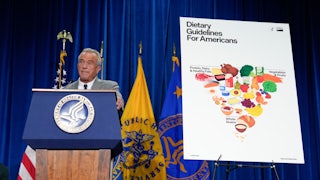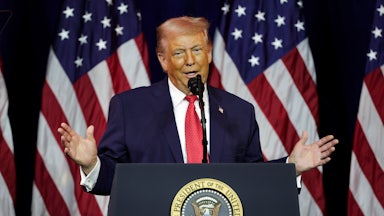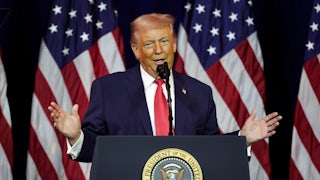Co-written by a molecular biology postdoc and a British viscount, the new pop science book Viral is positioned as the reasonable person’s guide to the Covid-19 “lab leak” theory. The authors bristle at the suggestion that they are trafficking in conspiracy theories. After all, they are not indulging in wild conjectures about China releasing a bioweapon in Wuhan, or the Covid-19 virus being made from HIV. They insist they are merely asking serious questions about a possible laboratory accident. The promotional blurb from HarperCollins U.K. touts the authors’ scientific brilliance and promises the team will use “their formidable skills to scrutinise arguments and rigorously analyse the sprawling data,” while HarperCollins U.S. promises “a gripping detective story that takes the reader deeper and deeper into a metaphorical cave of mystery.”
The lab leak theory, for the uninitiated, is the notion that the Covid-19 virus that has now devastated the globe is not of purely natural origin but rather escaped from a lab after it was harvested from the wild or engineered by Chinese scientists. It’s not actually a single theory but, rather, a grab bag of possible scenarios by which the virus might have been unleashed on the world—all of them implying some level of shady or incompetent behavior by Chinese scientists. And in trying to take each of these scenarios seriously, Viral’s authors have unintentionally exposed the entire farce of the lab leak discourse—showing both the exceptional flimsiness of the lab leakers’ narrative and also why this very flimsiness makes the lab leak conspiracy theory so hard to eradicate. By relying on an ever-growing arsenal of seemingly suspicious facts, each pointing in a slightly different direction, lab leaker discourse renders itself completely unfalsifiable.
Alina Chan, a postdoctoral researcher at the Broad Institute in Massachusetts, is one of Twitter’s leading purveyors of impassioned questions about lab leaks. Her co-author is Matt Ridley, a well-known science writer, Conservative hereditary peer, and coal baron who’s notorious for hyping the “benefits” of global warming, misrepresenting his think tank’s climate work as peer-reviewed, and presiding over the implosion of a major British mortgage bank. In 2000, Ridley championed a theory of a lab-linked origin for HIV based on the research of an amateur sleuth.
The authors refuse to make a case for any particular origin story in Viral. They claim to be agnostic about whether the Wuhan Institute of Virology engineered the SARS-CoV-2 virus that causes Covid-19, created the virus accidentally, or sampled it from the wild and lost control of it—or whether the virus jumped naturally from animals to humans like the first two pandemic coronaviruses, SARS and MERS and countless new human viruses throughout history.
But despite their performance of neutrality, the authors’ allegiances clearly lie with some version of a lab leak. The first clue to this is that the primary intellectual partners Chan and Ridley select for their quest to understand the origins of the pandemic are not virologists or epidemiologists but, rather, a group of self-styled internet sleuths known as Decentralized Radical Autonomous Search Team Investigating Covid-19, or DRASTIC. The second is that, despite spending an exhausting amount of time reassuring the reader that the book is not promoting conspiracy theories, most of the scenarios Ridley and Chan entertain would require improbably large and durable conspiracies to hide all solid evidence of a lab leak for at least two years.
The book is structured around a set of themes, which I hesitate to call arguments because the authors decline to argue for anything in particular. (In this sense, the book aligns perfectly with what academics have been saying about conspiracy theories for years: that the theories rely on people poking holes in the official narrative without committing to a single plausible alternative.) First, the authors attach great importance to a mysterious pneumonia outbreak linked to the abandoned Tongguan mineshaft in Mojiang, China, in April 2012, which lab leak theory adherents see as a critical episode in the history of Covid-19, because researchers with the Wuhan Institute of Virology later found the bat virus RaTG13 in that same cave, and RaTG13 was briefly the closest-known wild relative of the SARS-CoV-2 virus that causes Covid-19. Second, the authors focus on the purported evidence of “preadaptation” of Covid-19 to human hosts. Finally, they examine gaps in the epidemiological record that purportedly call into question the current scientific consensus that the pandemic began in the Huanan Seafood Wholesale Market in Wuhan, following a “spillover” event in which the virus passed from a live animal to a human.
A series of recent discoveries, however, has undermined Viral’s central themes: Newly discovered wild bat viruses from Laos have proven not only more genetically similar to the Covid-19 virus than any previously known to science, including the Wuhan Institute of Virology’s RaTG13 sequence, but also directly infectious to humans via the same mechanisms that the Covid-19 virus uses to infect human cells. These findings make Viral’s breathless speculation about the Mojiang mine and the origins of RaTG13 completely obsolete. This discovery also suggests that whatever “preadaptation” was needed to make Covid-19 infectious to humans could have happened in the wild over many years of natural selection. The Laos bat preprint was published in mid-September, by which time it may have been too late to address it in the book.
Meanwhile, a reanalysis of early Covid cases published in November in the journal Science has confirmed the Huanan Seafood Wholesale Market as the likely site of a zoonotic spillover event. Another paper, which gets a brief discussion in the book, established beyond a reasonable doubt that, contrary to Chinese government denials, live wild-caught animals that could be prime viral vectors were illegally sold at the Huanan market through November 2019—including raccoon dogs, hog badgers, and Siberian weasels, all members of the carnivorous mustelid family, which is known to be susceptible to SARS-like coronaviruses.
Lab leakers have done their best to cast doubt on the idea that the pandemic originated at the Huanan seafood market. That’s a tall task, given that between half and two-thirds of the earliest known cases of Covid-19, depending on how you count, have a direct connection to a market the size of a football field. By contrast, there is no geographic or social pattern implicating the Wuhan Institute of Virology’s campuses or its staff—whom lab leak theorists prefer to blame for the outbreak.
Lab leak theory boosters have argued that the apparent ties to the market were mere ascertainment bias: Public health authorities suggested that doctors ask about ties to the market, so they found more ties. But a recent reanalysis of the earliest cases published in Science in November shows that a disproportionate number of early cases were linked to the market even before the official announcement. The same paper revealed that the first documented case of Covid-19 was a female seafood vendor at the Huanan market (rather than a 41-year-old accountant with no ties to the market who had originally been identified as the earliest known case).
Chan and Ridley’s focus on RaTG13 as a somewhat unclear alternative story to the Huanan market thesis may be the weakest part of this entire narrative. “That the closest relative of SARS-CoV-2, RaTG13, came to Wuhan via scientists shifts the burden of proof,” the authors assert. But even before the September revelation of three viruses more similar to the Covid-19 one than RaTG13, the supposed RaTG13 story didn’t make much sense.
Chan and Ridley seem to find it suspicious, for instance, that the Wuhan Institute of Virology didn’t make a bigger deal of RaTG13 at the time, or mention when it published news of its discovery in 2016 that it was the same cave where the miners had gotten sick years earlier.
Are Chan and Ridley alleging that the WIV made the Covid-19 virus out of RaTG13? Not exactly, although at one point they “just ask some questions” about whether the WIV had a secret pangolin research program. This is a nod to a popular DRASTIC theory that the WIV (or some other lab) grafted a pangolin spike protein (or something like that but secret) onto RaTG13 (or something like that but also secret).
Their real point appears to be that the WIV’s handling of the RaTG13 discovery seems underhanded and therefore we can’t rule out that one of the other coronaviruses it says it sampled from the Mojiang mine might have been the Covid-19 virus or something that could have been engineered into it. They find it interesting, for example, that the miners who got sick in 2012 suffered from symptoms that seem similar to Covid-19. (This isn’t quite accurate: Those miners suffered from wet, often bloody coughs, as opposed to the signature dry cough of Covid-19. And many of their other symptoms overlapped with atypical pneumonias caused by fungi, bacteria, or physical irritants.)
When a team from the Wuhan Institute of Virology visited the mine and took samples, they were able to piece together the genetic code of a virus they originally called BtCoV/4991 and then renamed RaTG13. Lab leak theorists also think this is suspicious—perhaps an attempt to obfuscate. This is a particularly odd thing to focus on, given that RaTG13 is short for “Hear ye, hear ye: We found this sequence in an R. affinis bat in the Tongguan mineshaft in 2013.”
The September discovery of the three more similar viruses in Laos is incredibly damaging to the RaTG13 theory. Unlike RaTG13, these three viruses have spike proteins that enable them to enter human cells via the ACE2 receptor, just as the virus that causes Covid-19 does. Subsequent experiments showed that these viruses bind as effectively to the ACE2 receptor protein as the early strains of Covid did. These discoveries strike at the heart of the primary scientific argument for a lab leak, which is that Covid’s rapid person-to-person spread in the early weeks of the pandemic, while it accumulated so few mutations, must mean that it was “preadapted” to humans in a lab.
While it’s possible Viral’s authors didn’t have time before publication to incorporate this news, they could, given their big show of considering both sides, have emphasized a different fact: It was clear from the outset that RaTG13 is not the direct ancestor of the Covid-19 virus. The 96.2 percent similarity between the two viruses represents decades of evolutionary divergence. Nor, as I’ve previously reported, could anyone have made the Covid-19 virus using RaTG13 as a backbone. As multiple experts have pointed out, you’d need to start with a virus that was at least 99 percent similar to Covid’s to do that. As far as anyone knows, neither the Wuhan Institute of Virology nor any laboratory in the world had a strain that was that similar to the Covid-19 virus, nor did it even have the full live virus genetic sequence of RaTG13—all it had was something pieced together like high-tech taxidermy, which wouldn’t have been possible to grow in a petri dish. Viral does a pretty good job of highlighting risky research that may have been undertaken or planned for the Wuhan Institute of Virology. But the fact remains that a lab can’t leak what it hasn’t got.
In lieu of acknowledging that WIV researchers are scientists, not wizards, Viral points to more facts that seem vaguely shady. It devotes pages to discussing, for example, a database listing animal samples and viral sequences developed by the WIV that supposedly went offline on September 12, 2019.
As with so much of lab leak discourse, the allegations are not clearly specified. The insinuation seems to be that the database was taken offline because the Wuhan Institute of Virology was hiding a leak, but the timing makes no sense. If the coronavirus was released into the middle of Wuhan on, or possibly before September 12, why didn’t doctors notice atypical pneumonia admissions rising until late December? Scattered hospitalizations for what we now know was Covid-19 started around December 10, and cases no doubt started climbing before that, but the idea that a virus this contagious could have been circulating below the radar in Wuhan for at least two months beggars belief. In addition, the September leak idea contradicts another popular lab leak scenario, also given a sympathetic hearing in the book, which focuses on three workers from the coronavirus lab at the WIV having gone to the hospital with flulike symptoms in November. This rumor is frequently dangled as evidence that the first known human cases of Covid-19 were linked directly to the lab, even though these workers could just as easily have had the flu, and the WIV denies that any employees tested positive for Covid-19 antibodies.
Chan and Ridley are touchy about any suggestion that they are trafficking in conspiracy theories. “As if an accident could be a conspiracy,” they scoff. But all of the scenarios they seem to find significant matter only if they convince us there’s a major cover-up afoot: If the WIV has been deliberately hiding the link between the Tongguan mineshaft and RaTG13 since 2016, for instance, that would indeed be a conspiracy. If the database was taken down to hide something, that too would be a conspiracy. If the WIV is lying about the blood tests that showed that none of its employees had Covid-19 in November 2019, or if the Chinese government has already done all the tests that would establish the lab origin of Covid-19, but it is selectively releasing only the evidence that supports a natural origin—as the book insinuates—all of the above would require the collusion of large numbers of people.
When you raise concrete objections to one theory, lab leakers throw out a slightly different version. If Covid-19 couldn’t be made from RaTG13, what if it was made from some other virus like RaTG13? No social or geographic link to the Wuhan Institute? Well, maybe it was some other lab we don’t know about. No obvious signs of genetic modification? Suppose they used an invisible technique? None of these scenarios is prima facie impossible, and therefore, once raised, none can be dismissed out of hand. But none of them is supported by any evidence whatsoever. And if you don’t like those, they have others. They’re just asking questions, here.
The through line in all of these possible scenarios is that there is no through line. There’s no overarching coherent narrative about when or how this “lab leak” happened. And in making that clear, Viral also shows why the very weakness of the lab leak case is also its greatest strength: The great part about suspicions—from a conspiracy theorist’s perspective—is that they don’t have to gel into any coherent theory. You can just have a bad feeling that becomes someone else’s job to resolve for you.
This is why the lab leak theory will never die, no matter how much evidence virologists are patiently accumulating on the side of natural origin. It’s all about suspicion and innuendo. And when one supposedly suspicious event is unpacked, it’s usually a long and boring explanation nobody wants to hear. Meanwhile, the theorists have already found 10 more things that seem spooky to them. Conspiracy theories, we’re learning, are even harder to eradicate than infectious diseases.










